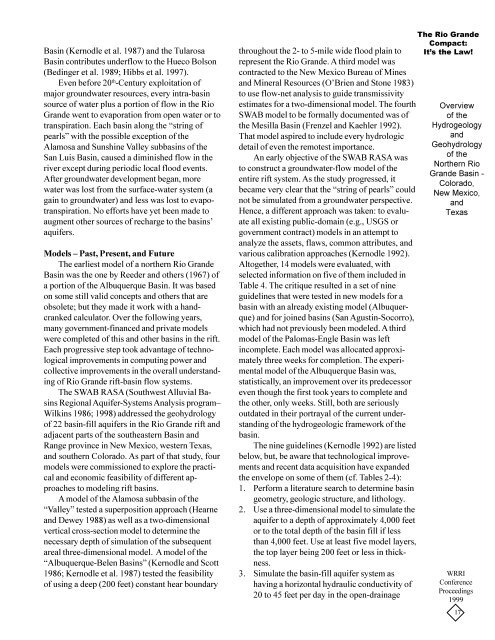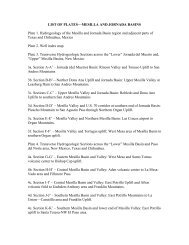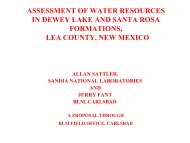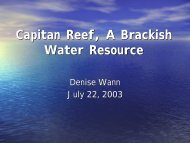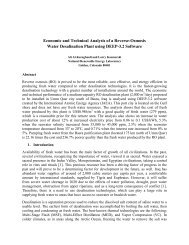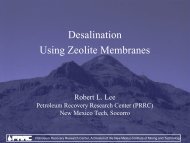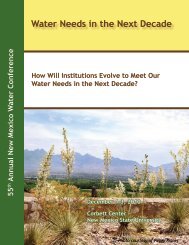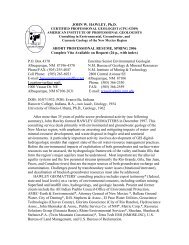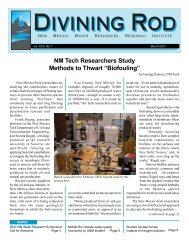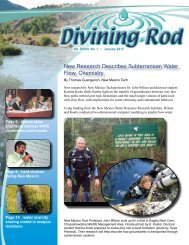Overview of the Groundwater Hydrology of the Rio Grande Basin
Overview of the Groundwater Hydrology of the Rio Grande Basin
Overview of the Groundwater Hydrology of the Rio Grande Basin
Create successful ePaper yourself
Turn your PDF publications into a flip-book with our unique Google optimized e-Paper software.
<strong>Basin</strong> (Kernodle et al. 1987) and <strong>the</strong> Tularosa<strong>Basin</strong> contributes underflow to <strong>the</strong> Hueco Bolson(Bedinger et al. 1989; Hibbs et al. 1997).Even before 20 th -Century exploitation <strong>of</strong>major groundwater resources, every intra-basinsource <strong>of</strong> water plus a portion <strong>of</strong> flow in <strong>the</strong> <strong>Rio</strong><strong>Grande</strong> went to evaporation from open water or totranspiration. Each basin along <strong>the</strong> “string <strong>of</strong>pearls” with <strong>the</strong> possible exception <strong>of</strong> <strong>the</strong>Alamosa and Sunshine Valley subbasins <strong>of</strong> <strong>the</strong>San Luis <strong>Basin</strong>, caused a diminished flow in <strong>the</strong>river except during periodic local flood events.After groundwater development began, morewater was lost from <strong>the</strong> surface-water system (again to groundwater) and less was lost to evapotranspiration.No efforts have yet been made toaugment o<strong>the</strong>r sources <strong>of</strong> recharge to <strong>the</strong> basins’aquifers.Models – Past, Present, and FutureThe earliest model <strong>of</strong> a nor<strong>the</strong>rn <strong>Rio</strong> <strong>Grande</strong><strong>Basin</strong> was <strong>the</strong> one by Reeder and o<strong>the</strong>rs (1967) <strong>of</strong>a portion <strong>of</strong> <strong>the</strong> Albuquerque <strong>Basin</strong>. It was basedon some still valid concepts and o<strong>the</strong>rs that areobsolete; but <strong>the</strong>y made it work with a handcrankedcalculator. Over <strong>the</strong> following years,many government-financed and private modelswere completed <strong>of</strong> this and o<strong>the</strong>r basins in <strong>the</strong> rift.Each progressive step took advantage <strong>of</strong> technologicalimprovements in computing power andcollective improvements in <strong>the</strong> overall understanding<strong>of</strong> <strong>Rio</strong> <strong>Grande</strong> rift-basin flow systems.The SWAB RASA (Southwest Alluvial <strong>Basin</strong>sRegional Aquifer-Systems Analysis program–Wilkins 1986; 1998) addressed <strong>the</strong> geohydrology<strong>of</strong> 22 basin-fill aquifers in <strong>the</strong> <strong>Rio</strong> <strong>Grande</strong> rift andadjacent parts <strong>of</strong> <strong>the</strong> sou<strong>the</strong>astern <strong>Basin</strong> andRange province in New Mexico, western Texas,and sou<strong>the</strong>rn Colorado. As part <strong>of</strong> that study, fourmodels were commissioned to explore <strong>the</strong> practicaland economic feasibility <strong>of</strong> different approachesto modeling rift basins.A model <strong>of</strong> <strong>the</strong> Alamosa subbasin <strong>of</strong> <strong>the</strong>“Valley” tested a superposition approach (Hearneand Dewey 1988) as well as a two-dimensionalvertical cross-section model to determine <strong>the</strong>necessary depth <strong>of</strong> simulation <strong>of</strong> <strong>the</strong> subsequentareal three-dimensional model. A model <strong>of</strong> <strong>the</strong>“Albuquerque-Belen <strong>Basin</strong>s” (Kernodle and Scott1986; Kernodle et al. 1987) tested <strong>the</strong> feasibility<strong>of</strong> using a deep (200 feet) constant hear boundarythroughout <strong>the</strong> 2- to 5-mile wide flood plain torepresent <strong>the</strong> <strong>Rio</strong> <strong>Grande</strong>. A third model wascontracted to <strong>the</strong> New Mexico Bureau <strong>of</strong> Minesand Mineral Resources (O’Brien and Stone 1983)to use flow-net analysis to guide transmissivityestimates for a two-dimensional model. The fourthSWAB model to be formally documented was <strong>of</strong><strong>the</strong> Mesilla <strong>Basin</strong> (Frenzel and Kaehler 1992).That model aspired to include every hydrologicdetail <strong>of</strong> even <strong>the</strong> remotest importance.An early objective <strong>of</strong> <strong>the</strong> SWAB RASA wasto construct a groundwater-flow model <strong>of</strong> <strong>the</strong>entire rift system. As <strong>the</strong> study progressed, itbecame very clear that <strong>the</strong> “string <strong>of</strong> pearls” couldnot be simulated from a groundwater perspective.Hence, a different approach was taken: to evaluateall existing public-domain (e.g., USGS orgovernment contract) models in an attempt toanalyze <strong>the</strong> assets, flaws, common attributes, andvarious calibration approaches (Kernodle 1992).Altoge<strong>the</strong>r, 14 models were evaluated, withselected information on five <strong>of</strong> <strong>the</strong>m included inTable 4. The critique resulted in a set <strong>of</strong> nineguidelines that were tested in new models for abasin with an already existing model (Albuquerque)and for joined basins (San Agustin-Socorro),which had not previously been modeled. A thirdmodel <strong>of</strong> <strong>the</strong> Palomas-Engle <strong>Basin</strong> was leftincomplete. Each model was allocated approximatelythree weeks for completion. The experimentalmodel <strong>of</strong> <strong>the</strong> Albuquerque <strong>Basin</strong> was,statistically, an improvement over its predecessoreven though <strong>the</strong> first took years to complete and<strong>the</strong> o<strong>the</strong>r, only weeks. Still, both are seriouslyoutdated in <strong>the</strong>ir portrayal <strong>of</strong> <strong>the</strong> current understanding<strong>of</strong> <strong>the</strong> hydrogeologic framework <strong>of</strong> <strong>the</strong>basin.The nine guidelines (Kernodle 1992) are listedbelow, but, be aware that technological improvementsand recent data acquisition have expanded<strong>the</strong> envelope on some <strong>of</strong> <strong>the</strong>m (cf. Tables 2-4):1. Perform a literature search to determine basingeometry, geologic structure, and lithology.2. Use a three-dimensional model to simulate <strong>the</strong>aquifer to a depth <strong>of</strong> approximately 4,000 feetor to <strong>the</strong> total depth <strong>of</strong> <strong>the</strong> basin fill if lessthan 4,000 feet. Use at least five model layers,<strong>the</strong> top layer being 200 feet or less in thickness.3. Simulate <strong>the</strong> basin-fill aquifer system ashaving a horizontal hydraulic conductivity <strong>of</strong>20 to 45 feet per day in <strong>the</strong> open-drainageThe <strong>Rio</strong> <strong>Grande</strong>Compact:It’s <strong>the</strong> Law!<strong>Overview</strong><strong>of</strong> <strong>the</strong>HydrogeologyandGeohydrology<strong>of</strong> <strong>the</strong>Nor<strong>the</strong>rn <strong>Rio</strong><strong>Grande</strong> <strong>Basin</strong> -Colorado,New Mexico,andTexasWRRIConferenceProceedings199917


